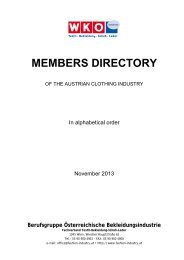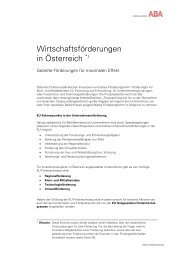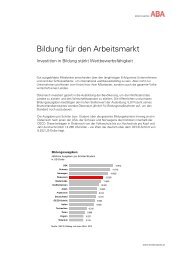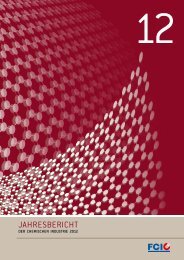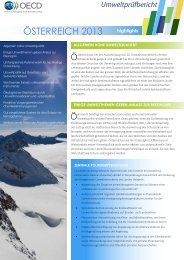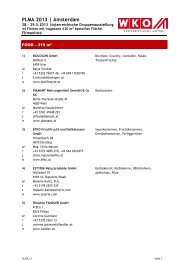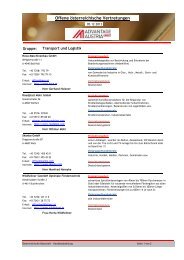AE Lebensmittel_ok.indd - Advantageaustria.org
AE Lebensmittel_ok.indd - Advantageaustria.org
AE Lebensmittel_ok.indd - Advantageaustria.org
Erfolgreiche ePaper selbst erstellen
Machen Sie aus Ihren PDF Publikationen ein blätterbares Flipbook mit unserer einzigartigen Google optimierten e-Paper Software.
Happy chickens kept in a natural way means well-aired, protected nests to sleep in<br />
and sand they can clean themselves with.<br />
Organic food is healthy, and this view is shared by 90%<br />
of all domestic consumers of such products. They justify<br />
this belief by mentioning that <strong>org</strong>anic foods are “free of<br />
chemicals” and “GM-free”. Those are the most important<br />
factors when purchases are made. This is followed by enjoyment<br />
and the knowledge that an environmentally friendly<br />
purchase is being made, at the second and third places, respectively,<br />
according to a study AMA Marketing commissioned<br />
the Marketmind market-research institute to perform.<br />
While <strong>org</strong>anic agriculture has the least impact on the<br />
environment of all types, it involves more than merely<br />
avoid ing the use of chemicals and genetic technology. The<br />
basis is a holistic approach, in which high-quality food products<br />
are produced in a way that consumes the fewest<br />
possible natural resources.<br />
Concretely, this involves the following:<br />
Resources are used in cycles that are as closed as possible:<br />
as few materials as possible are purchased, what the<br />
farm itself produces is recycled. This applies to compost<br />
and fertiliser (manure) in particular.<br />
No artifi cial fertiliser: <strong>org</strong>anic farms use no fertilisers that<br />
harm the environment or consume excessive amounts of energy<br />
for the farming of grain, fi eld crops, fruit or vegetables.<br />
No synthetic herbicides, pesticides or fungicides: <strong>org</strong>anic<br />
farmers do not spread synthetic plant protectives; all<br />
pests, diseases and weeds are held in check in a way that<br />
supports ecological balance.<br />
AUSTRI<strong>AE</strong>XPORT<br />
Artgerechte Hühnerhaltung bedeutet u. a. geschützte Nester, Sand für Staubbäder<br />
und luftige, geschützte Plätzchen für die Nachtruhe.<br />
Denn biologische <strong>Lebensmittel</strong> sind gesund – diese Meinung<br />
wird von 90 Prozent der heimischen Bio-KonsumentInnen<br />
vertreten. Sie begründen dies damit, dass biologische<br />
<strong>Lebensmittel</strong> „chemiefrei“ und „gentechnikfrei“<br />
sind. Das sind die wichtigsten Faktoren für die Kaufentscheidung.<br />
An zweiter und dritter Stelle folgen das Genussargument<br />
und der umweltbewusste Einkauf. Dies geht aus<br />
einer vom Marktforschungsinstitut „Marketmind“ im Auftrag<br />
der AMA Marketing durchgeführten Studie hervor.<br />
Die Biolandwirtschaft gilt als die umweltschonendste<br />
Form der Landbewirtschaftung. Bio ist aber mehr als der<br />
Verzicht auf Chemie oder Gentechnik.<br />
Dahinter steckt ein ganzheitlicher Ansatz, auf dessen<br />
Basis hochwertige <strong>Lebensmittel</strong> unter Schonung der natürlichen<br />
Ressourcen erzeugt werden.<br />
Das bedeutet konkret:<br />
Möglichst geschlossene Kreisläufe im Biobetrieb: Betriebsmittel<br />
werden nach Möglichkeit nicht zugekauft, sondern<br />
es wird wiederverwendet, was am Hof anfällt. Das gilt<br />
besonders für Kompost und Düngemittel (Mist, Gülle).<br />
Kein Kunstdünger: Biobetriebe verwenden beim Anbau<br />
von Getreide, Feldfrüchten, Obst und Gemüse keine umweltschädigenden<br />
und energieintensiven Kunstdünger.<br />
Keine synthetischen Pfl anzenschutzmittel: BiobäuerInnen<br />
bringen keine chemisch-synthetischen Pfl anzenschutzmittel<br />
aus, sondern halten Schädlinge, Krankheiten und<br />
Unkräuter durch Förderung des ökologischen Gleichgewichts<br />
in Schach.<br />
127/2008 www.advantageaustria.<strong>org</strong><br />
11<br />
© BMLFUW / AMA-Bioarchiv © Proholz



